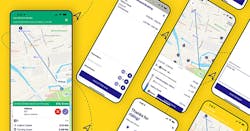It is more than just the US, which struggles with public transit reach. In 2013, Helsinki, Finland, launched the first on-demand public transport solution, Kutsuplus. It was lauded as the breakthrough in changing residents' dependency on cars (although they realized that people would still need their cars for travel outside the city). The Guardian newspaper said in 2014 'Finland's capital hopes a mobility-on-demand system that integrates all forms of shared and public transport in a single payment network could essentially render private cars obsolete by 2025". The problem Kutsuplus intended to solve was the limitations of the Helsinki subway and the fact that most buses ran north to south. It matched riders with others going in the same direction with a minibus. The cost was more than a bus but less than a taxi. Following a pilot in 2012, the service grew to 21,000 registered users. However, by 2015 it was decided that to make Kutsuplus a success, it needed to scale up significantly. This was deemed too costly, and the service was closed down. However, Kutsuplus has paved the way for other solutions in the future.
The provision of on-demand has since been made possible by the emerging technology of smartphones, mobile ticketing and real-time scheduling and dispatch. In addition, disruptive operators such as UBER and LYFT arrived on the scene and provided sufficient capacity and competitive pricing to offer cost-effective on-demand transit.
An excellent example is Dallas Area Rapid Transit (DART)'s award-winning GoPass ® branded mobile ticketing and trip planner app, which has led with many industry-first features over the past ten years. In 2015, Dallas Area Rapid Transit (DART) had access to federal funds to see how on-demand microtransit services could be integrated into their GoPass ® mobile ticketing and trip planner solution. Fast forward to the present day, and DART's GoPass ® branded mobile ticketing and trip planner application has integrations to multiple on-demand service providers, complemented with deep integrations to TNC services such as UBER and LYFT to support rider-choice-based microtransit and paratransit programs.
The major differentiator with DART is the integration into the integral business of the service. As a result, DART now has the most extensive system of on-demand transit in the world.
How does it work?
DART uses multiple providers, including their GoLink services, UBER, and LYFT, making the system more flexible and responsive. By requesting a ride in the GoPass ®app, the user is serviced by a fleet of vehicles in the designated area, and riders are matched with the best available option. On-demand fits around the user, not the other way around. It offers a solution to first/last mile problems, short point-to-point trips within a zone and links to transit hubs allowing more access to traditional public transit. In addition, it is affordable as it is included in the GoPass ® ticket giving more access and equity to a broader range of users.
DART's GoPass ® app is powered by Unwire, an innovative company built on more than two decades of experience with mobile solutions and public transit fare collection.
Unwire delivered one of the first mobile ticketing solutions to the market back in 2008 when they introduced mobile ticketing to Stockholm in Sweden, and one of the first mobile ticketing solutions for smartphones in the United States in 2013, when they launched the GoPass® branded mobile app solution with Dallas Area Rapid Transit (DART) in Texas. Today, Unwire serves multiple transit agencies and cities in the United States with its white-label mobility platform.
So what makes the Unwire app solution unique?
First, on-demand is integral to the wider solution, where riders can plan, book, and pay for their multi-modal journeys in one place, receive important information, and engage in two-way communication with the agency through the app. The planning functionality allows planning an entire trip from start to finish on public transit within the service area regardless of access to fixed-route public transit. In large cities with a significant student population, on-demand transit is, well, very in demand. In some cases, on-demand becomes the primary mode of transport, not an additional service. It allows the agency to concentrate its buses on high-frequency and high-use routes without excluding other riders.
"The Unwire solution has a particularly unique selling point. It is the first in the US to integrate multiple on-demand service providers, such as Spare and RideCo, into one platform, complemented with deep integrations to TNC services such as UBER and LYFT. On-demand is not an addition to the solution but is completely integrated. Riders can access services such as LYFT and UBER without having accounts.
"Unwire has a unique skill set that solves a real-life problem of access to public transport wherever you live in the transit zone. The ease with which users can plan, book and pay for their entire journey in one app is a game changer and immediately makes public transit more accessible to more people. Add the fare capping the solution offers; it makes it very affordable for the rider and much more cost-effective for the agency," confirmed David Leininger, retired CFO for Dallas Area Rapid Transit.
He added, "this integrated solution is especially relevant for smaller and mid-sized urban markets where the deployment of a fixed route bus network is not financially nor operationally feasible. However, if a combination of taxis and drivers providing UBER and LYFT services exists in that market area, the solution can be deployed and ensure residents have near-universal public transit coverage. Large or small, all markets have transit-dependent residents, be they elderly, young, disabled or lacking reliable daily transportation."
And the great news is that any transit agency can access this innovative system with Unwire's solution, which is the only one offering full integration with multiple on-demand software providers and third-party transportation operators. It is a robust system which allows agencies to offer a more equitable and improved service with lower costs than expanding fixed routes to widen access to public transit.


